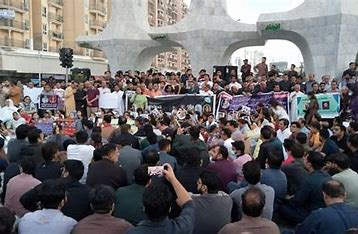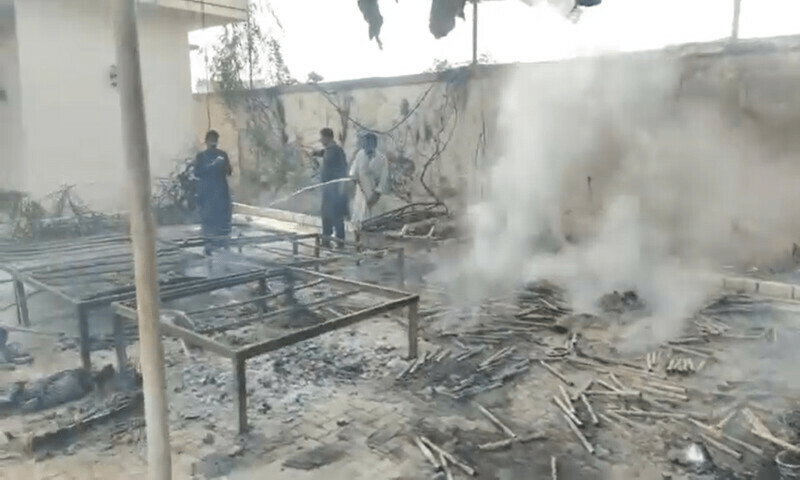
The southern Pakistani province of Sindh has witnessed an unprecedented wave of unrest and violence triggered by protests against a contentious canal project. What began as peaceful demonstrations quickly escalated into chaos, culminating in the shocking arson attack on the residence of the Sindh Home Minister and the tragic deaths of two protestors after security forces opened fire.
This turmoil has shaken the province to its core and thrust a longstanding water dispute and political discontent into the national spotlight. As millions of Sindhis grapple with the dual crises of resource scarcity and political instability, the canal project has become a flashpoint that exposes deeper fissures in governance, resource management, and regional identity.
Historical Background: Water and Politics in Sindh
Sindh, Pakistan’s third-largest province, is heavily dependent on agriculture, which in turn depends on the Indus River—the lifeline of the region. Since the creation of Pakistan in 1947, Sindh’s access to water has been a subject of intense negotiation, conflict, and controversy.
The Indus Waters Treaty of 1960, brokered between India and Pakistan, allocated the waters of the Indus River and its tributaries, but internal distribution among Pakistan’s provinces remained a thorny issue. Sindh, situated downstream, has often accused the upstream provinces of Punjab and Khyber Pakhtunkhwa of diverting excessive water, threatening Sindh’s agricultural output and the livelihoods of millions.
This water scarcity has been a cause of repeated protests and political unrest over decades, with water rights deeply entwined with provincial autonomy and ethnic identity. The current canal project is viewed by many as a continuation of this pattern of perceived injustice and neglect.
The Canal Project: Development or Dispossession?
The canal project at the center of the current protests was officially launched by the Sindh government with the stated objective of improving irrigation efficiency and addressing water shortages. According to officials, the canal aims to channel water to parched agricultural areas, thereby boosting crop yields and enhancing food security.
However, local communities and opposition groups vehemently reject these claims. They argue that the canal’s design disproportionately benefits certain regions, mainly those politically aligned with the ruling party, while depriving vast swathes of Sindh’s rural population of essential water.
Farmers from the most affected areas have warned that the canal will lead to desertification, loss of arable land, and a humanitarian crisis. The project has thus become emblematic of a broader struggle over resources and power within Sindh.
Escalation: From Protest to Violence
The initial protests were fueled by grassroots anger over the canal’s perceived unfair impact. Small gatherings soon mushroomed into mass demonstrations, with thousands demanding the project’s halt and accountability from the provincial government.
Tensions reached a boiling point when protestors stormed and set fire to the home of the Sindh Home Minister. This act was a dramatic expression of public fury, symbolizing a profound breakdown in trust between the government and its people.
The government’s response was swift and harsh. Security forces were deployed in large numbers, employing tear gas, baton charges, and live ammunition in attempts to quell the unrest. Tragically, two protestors lost their lives in the ensuing clashes, further inflaming passions and drawing condemnation from human rights activists.
Human Cost: Families Torn Apart and Communities in Fear
Beyond political ramifications, the violence has inflicted deep human suffering. Families of the deceased mourn their lost loved ones, while countless others live in fear of further confrontations.
The protests have disrupted daily life, with schools closing, businesses shuttering, and agricultural activities coming to a halt. Farmers and laborers, already vulnerable, face uncertain futures as their livelihoods hang in the balance.
Psychologists and social workers warn of a mounting mental health crisis triggered by violence, displacement, and economic insecurity. The province’s fragile social fabric is under immense strain.
The Political Fallout: Opposition Voices and Government Challenges
The opposition parties have seized on the crisis to criticize the ruling Pakistan Peoples Party (PPP) government in Sindh. Leaders accuse the government of mismanagement, neglect, and heavy-handedness, demanding the immediate resignation of key officials involved in the crackdown.
In the National Assembly, the issue has sparked heated debates, reflecting the broader tensions between federal and provincial authorities over governance and resource allocation.
Meanwhile, the PPP leadership defends its actions, arguing that law and order must be maintained and that the canal project is crucial for Sindh’s development.
Regional Implications: Sindh’s Identity and Autonomy at Stake

The protests are not only about water but also about the assertion of Sindhi identity and regional autonomy. For decades, Sindh has grappled with issues of political marginalization and cultural preservation.
The canal controversy has rekindled debates over provincial rights guaranteed under Pakistan’s constitution. Activists argue that control over water resources is fundamental to Sindh’s political and economic sovereignty.
The crisis has also raised concerns about potential spillover effects into neighboring provinces, threatening broader regional stability.
Environmental Dimensions: Water Scarcity, Climate Change, and Sustainability
Experts highlight that Sindh’s water problems are exacerbated by climate change, erratic rainfall patterns, and overuse of groundwater. The canal project, while intended as a solution, must be evaluated within this complex environmental context.
Sustainable water management, conservation efforts, and community participation are crucial to ensuring the province’s long-term resilience. Critics argue that unilateral projects without inclusive planning risk worsening ecological degradation.
Voices from the Ground: Farmers, Activists, and Ordinary Citizens Speak Out
The heart of the crisis lies with Sindh’s rural communities. Interviews with farmers reveal deep anxiety and frustration over the canal’s impact on their lands and water supply.
Activists call for transparent consultations and demand that any infrastructure projects prioritize the needs of the most vulnerable.
Ordinary citizens express fear for the future but also a strong determination to defend their rights and livelihoods.
International Attention and Human Rights Concerns
The violent crackdown and deaths have drawn international attention. Human rights organizations have urged Pakistan’s government to investigate the use of excessive force and ensure justice for victims.
The situation in Sindh is being watched closely by regional observers, given Pakistan’s strategic importance and the potential for internal unrest to impact broader geopolitical dynamics.
The Road Ahead: Possible Solutions and the Need for Dialogue
Resolving the Sindh canal crisis will require multi-faceted efforts:
- Genuine dialogue involving government, opposition, local communities, and experts to address grievances.
- Independent assessments of the canal’s environmental and social impact.
- Transparent and equitable water-sharing mechanisms.
- Strengthening provincial autonomy while fostering national unity.
- Investment in modern irrigation technologies and sustainable agriculture.
Only through inclusive, peaceful, and pragmatic approaches can Sindh hope to overcome this crisis and build a more just and prosperous future.
Conclusion: Sindh’s Waters, Identity, and Future
The violent protests and political upheaval in Sindh over the canal project reflect deeper currents shaping the province and Pakistan. Water is not just a resource but a symbol of life, power, and identity.
As the province wrestles with this crisis, the world watches a community striving to protect its rights, its environment, and its dignity. The decisions made now will reverberate for decades, determining whether Sindh sinks deeper into conflict or charts a path toward reconciliation and sustainable development.

